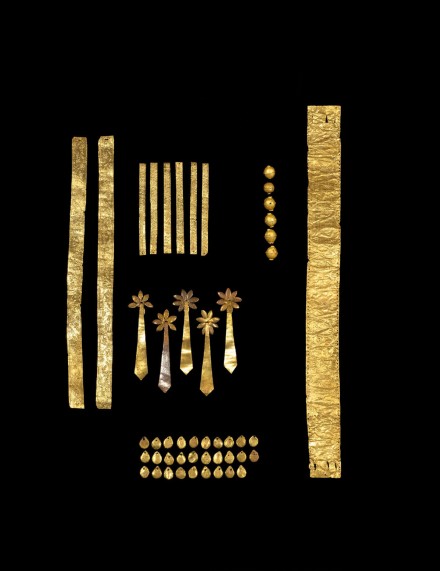J.J. Lally & Co., Oriental Art / New York City, New York
MenuPast Exhibition
Silver and Gold in Ancient China
March 16 – April 14, 2012

37.
A SET OF EARLY GOLD HEADDRESS ORNAMENTS
Northern Dynasties – Early Tang Dynasty, circa A.D. 5th-7th Century
comprising nine repoussé decorated bands, five florette tassels, six hollow beads, and twenty-nine sequins, the largest band decorated in shallow relief with a frieze of round-faced boys wearing lotus-petal skirts and bead necklaces shown grasping the strands of an undulating foliate scroll sprouting palmette motifs between beaded borders punched with tiny holes for attachment, the shorter two narrow bands each decorated with similar undulating foliate scroll sprouting palmette motifs in a continuous pattern between beaded borders, the six small bands decorated with overlapping undulating ropetwist pattern between beaded borders, the five tassels each in the form of an eight-petal florette pierced through the center to receive a thin pendant gold strip of tapered form, and the twenty-nine sequins all of teardrop shape, slightly convex on one side and concave on the other, pierced at the top for suspension, the six beads thinly cast with a mould line across the waist; all the elements showing a higher polish on the front and slightly matte on the reverse, one of the medium-size narrow bands with an ancient repair visible only on the back.
(approx 50 pieces)
Length of the repoussé bands 11 7⁄8 inches (30.3 cm); 8 5⁄8 inches (22 cm); 3 inches (7.5 cm)
Length of florette tassels 2 3⁄4 inches (7 cm)
Length of sequins 3⁄8 inch (1 cm)
Length of beads 3⁄8 inch (1 cm)
The decorative elements from an elaborate headdress, including gold bands, florette tassels, teardrop-shaped sequins, and ornaments with granulated borders, unearthed in 1988 from the tomb of Heruo at Xianyang, Shaanxi province, is illustrated in the catalogue of the special exhibition, Tō kotei kara no okurimono (Gifts of the Tang Emperors: Hidden Treasures from the Famen Temple), Niigata, 1999, p. 156, no. 113. The same set of gold ornaments was also illustrated in the catalogue of exhibition, Wu hua tian bao—Tang dai guizu de wuzhi shenghuo (Daily Life of Aristocrats in Tang China), Hong Kong, 1993, p. 56, no. 15.
Ornamental gold bands and a small gold crown and headdress decorated with the same undulating palmette scroll in repoussé and showing the same small pierced holes along the edges for attachment, are illustrated in the catalogue published by the Rietberg Museum, Chinesisches Gold und Silber: die Sammlung Pierre Uldry, Zurich, 1994, p. 141, no. 121, described as Northern Wei dynasty, early 6th century.
The motif of “putti-like” plump figures within running bands of undulating palmette-scroll between beaded ‘pearl’ borders, as seen on the present gold bands, is discussed by Juliano and Lerner in Monks and Merchants: Silk Road Treasures from Northwest China, Gansu and Ningxia Provinces, 4th-7th Century, New York, 2001, p. 80, where the authors cite examples on textiles, paintings and sculpture found at Dunhuang and other 5th-6th century Buddhist sites in Northern China, and illustrate a rubbing of this type of ornament found carved on a stone base in the tomb of Sima Jinlong (d. 484) at Datong, op. cit., p. 79, fig. D.
北朝–唐初 金頭飾一組
金箔帶 長 30.3、22、7.5 厘米; 金箔花繐飾 長 7 厘米; 金箔水滴形飾 長 1 厘米; 金珠 長 1 厘米
37.
A SET OF EARLY GOLD HEADDRESS ORNAMENTS
Northern Dynasties – Early Tang Dynasty, circa A.D. 5th-7th Century